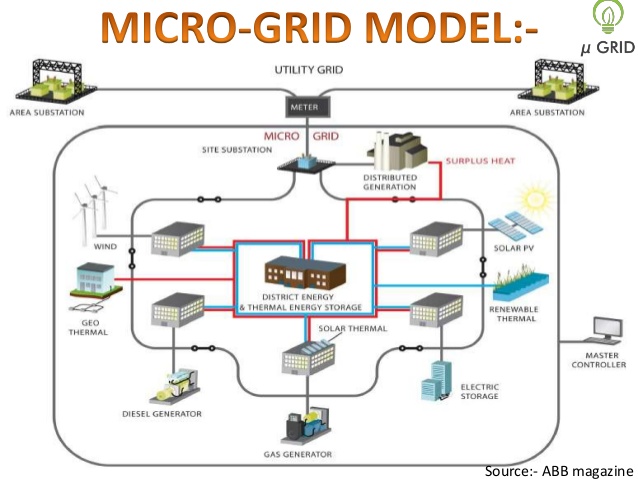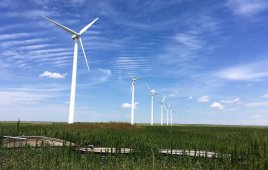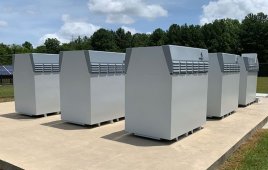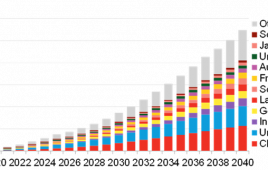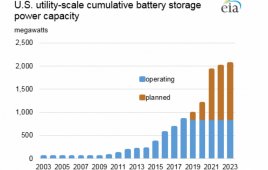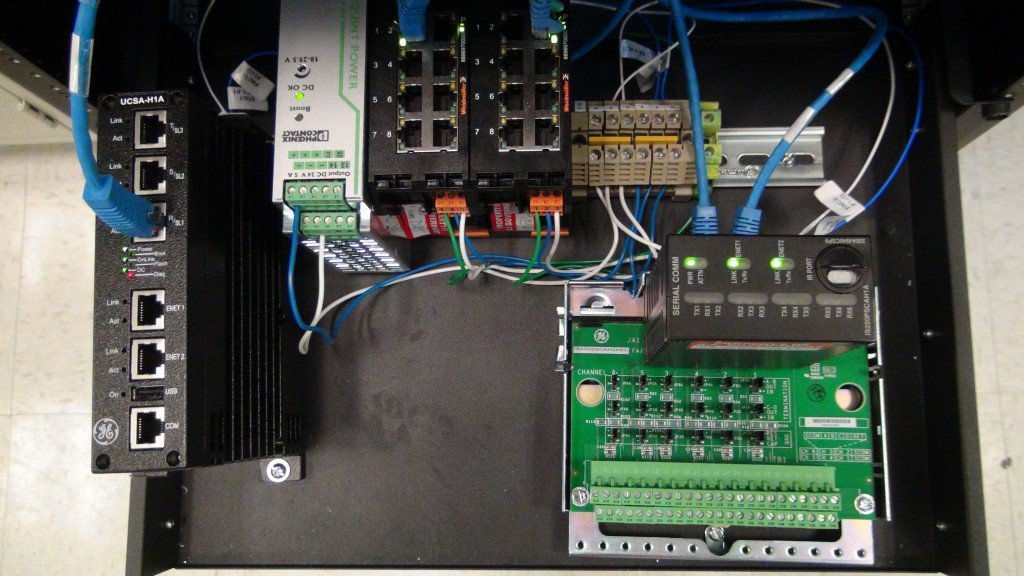
A typical GE control platform that can be used to host intelligent grid-management software for microgrids. Researcher Sumit Bose details the project developments for GE’s Enhanced Microgrid Control System (eMCS) in this video.
If you’re looking to invest in the energy market, you might want to consider the growing microgrid industry. At least that’s what Tesla Motors is doing. The maker of the sleek Model S electric car aspires to become a major player in the business of microgrids, and for good reason.
Recent analysis from Frost & Sullivan points to a significant spike in growth occurring from 2015 onwards with installations for microgrids increasing every year until 2020. Similar findings from Navigant Research predict the market will reach nearly $20 billion in annual microgrid-related revenue by 2020. Under a more aggressive scenario, this figure could reach even closer to $40 billion.
“Microgrids are inching their way into the mainstream, with the focus of the market shifting from technology validation to questions surrounding the most promising business models,” said Peter Asmus, principal research analyst with Navigant Research. As of 2Q 2015, the firm identified a total of 12,031 MW of microgrid capacity throughout the world, up from 4,393 MW in 2Q 2014—a near tripling of the known scope of the microgrid market.
What is a microgrid?
The U.S. Department of Energy defines a microgrid as “a group of interconnected loads and distributed energy resources within clearly defined electrical boundaries that acts as a single controllable entity with respect to the grid. A microgrid can connect and disconnect from the grid to enable it to operate in both grid-connected or island-mode.”
Basically, a microgrid is a distributed power system with the ability to self-supply, manage, and operate with or without the main grid as required. Microgrids do so through the use of a master controller that acts as the “brain” of the system, collecting data from connected energy sources while determining how to best control and operate that energy.
Through this brainpower, microgrids have the ability to improve power quality by reducing grid imbalances and providing a reliable supply of energy. They can also help solve intermittency issues commonly associated with renewable sources such as wind and solar power. Microgrids can serve as a back-up power source or bolster the main power grid during periods of heavy demand.
In recognition of the growing microgrid market, the U.S. Department of Energy has begun funding several grants to related projects. One of those grants went to utility provider ComED just last fall. They received a $1.2 million grant to build a first-of-its-kind master controller that could drive the operation of a cluster of microgrids, which connects multiple networks. ComED assembled a group of science and technology partners for the project, including Alstom Grid, S&C Electric, Schneider Electric, the University of Denver, and others. (Note: A total of seven projects received an award for approximately $1.2 million. Learn more here.)
“There is no doubt that microgrids will be core components of the future integrated grids and extensive research and development efforts will be undertaken in upcoming years,” said Amin Khodaei, Ph.D., from the University of Denver, in a related press statement. “The truly remarkable and distinguishing feature of this project is that it is initiated and will be led by a utility company.”
Utilities aren’t commonly known for their openness or acceptance of outside power sources, particularly ones that can work independently off the main grid. However, ComEd’s community-based microgrids have the potential to provide benefits to a city through improved reliability and enhanced resiliency in response to unexpected disasters or severe weather-related events.
A surge of serious weather events have occurred over the last few years, leading to more grid outages that could have been prevented with microgrids in place. In fact, the Village of Potsdam in northern New York, which is no stranger to harsh weather and ice storms that have damaged utility lines in the past, will serve as test grounds for an Enhanced Microgrid Control System (eMCS). This system is currently under development by General Electric (GE) and several partners, including the National Grid, with the aid of a $1.2 million grant from the DOE’s Office of Electricity Delivery and Energy Reliability (OE), $381,000 from the New York State Energy Research and Development Authority (NYSERDA), and an additional $300,000 from GE.
The purpose of this advanced microgrid system is to provide resilient, high-quality power to critical loads during power disruptions. The system is designed to work even if disconnected from the main power station for as long as two weeks.
“Together, GE’s control system and the underground microgrid envisioned for the Potsdam community, could serve as a model for towns and cities across the country that are susceptible to weather disasters and blackouts,” said Sumit Bose, principal investigator on the project and microgrid technology leader at GE Global Research.

Power and automation supplier, ABB, has partnered with wind energy company, Vestas, to electrify off-grid communities in Africa with low-cost wind-diesel generation combined with microgrids.
Remote power
The International Energy Agency (IEA) estimates that by 2020, developing countries will need to double their electrical power output.
“All told, the developing nations will represent 80% of total growth in energy production and consumption by the 2035,” this according to Navigant Research. “One could safely assume that the majority of these new power supplies will be produced and distributed via remote microgrids and other related forms of distributed energy resources.”
To meet this demand, companies are taking action and joining forces. Vestas’ Wind for Prosperity initiative, for instance, is a commercially based business model designed to bring affordable and reliable wind-generated electricity systems to rural populations in developing countries. One way they are doing so is by partnering with ABB, a power and automation supplier, to provide off-grid electricity to communities in Africa. Vestas is supplying re-furbished wind turbines and ABB is offering their microgrid power-stabilization solutions to create hybrid-generation systems that are well suited to operate in remote locations with limited infrastructure.
Canadian company Tugliq Energy has retained Hatch, a technical engineering and consulting firm, to engineer a microgrid control system for its wind and diesel energy storage demonstration project at a remote Arctic mine site in northern Québec. The five-year pilot project, which began in 2014, is testing wind-power integration on an islanded microgrid under severe Arctic climate conditions.
This hybrid system integrates renewable power and fossil fuel generation with the intent of maintaining grid stability and minimizing energy losses from wind curtailment (when the wind power supply is greater than the load). The pilot project is also testing three different storage technologies, including lithium-ion batteries, hydrogen, and flywheel storage. Flywheel devices store kinetic energy from the high-speed rotator.
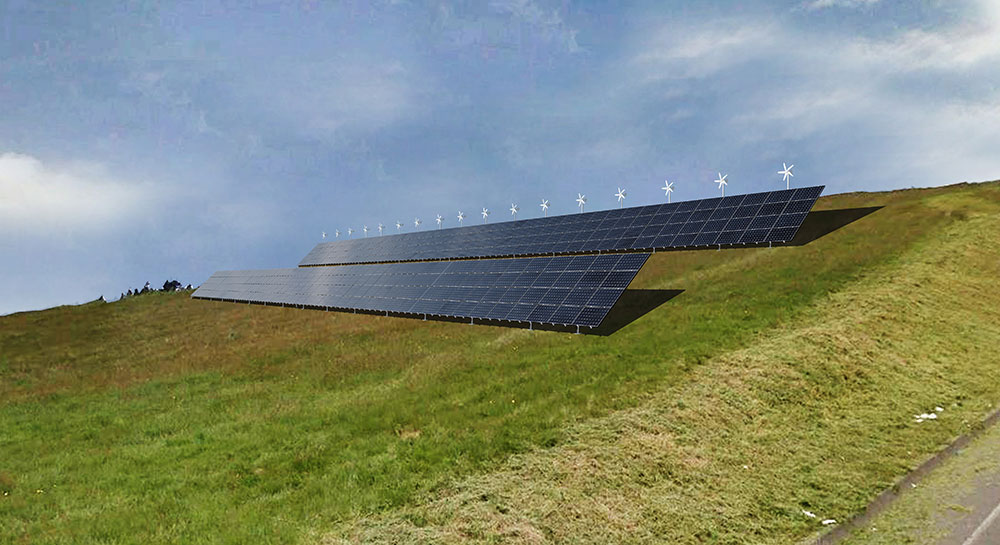
The new hybrid energy system currently under construction on the Bear River Band site in California is the only system of its kind combining wind and solar energy with an advanced energy storage system. The turbines are just visible above the solar array.
System size
SolarCity, a company that defines itself as America’s largest solar-power provider, is one of the first to incorporate Tesla’s lithium-ion battery technology. The result is that SolarCity is now able to configure and offer their solar system as a stand-alone, off-grid power supply.
According to the company website: “The combination of solar-power generation and battery storage will make the utility grid safer and less susceptible to service interruptions, and will also lower the cost to expand and maintain the grid.”
Initial plans are to present these off-grid systems to eligible customers in Hawaii who are otherwise prevented from using solar power.
The company is also expanding into larger community services. Because a microgrid can aggregate power production and demand from more than one source, it can serve multiple sectors. But when does a microgrid become a macrogrid? For some, even the community-scale system SolarCity offers stretches the limit of the term “micro.”
At its core is the ability of a microgrid to separate and isolate itself from the main grid (known as “islanding”), but for some communities especially in remote locations, the microgrid is the primary grid.
For California’s Bear River Band of the Rohnerville Rancheria, their new hybrid energy system currently under construction is the only system of its kind combining renewables with advanced energy storage. Working with JLM Energy, the system will include a 30-kW microgrid supported by a 100-kW PV solar system and 20 Zefr wind turbines.
The Tribe currently has a single 10-kW wind turbine that has provided power for a component of their wastewater treatment facility for a number of years. Developing more sustainable onsite power to reduce reliance on the main grid allows the Tribe more self-sufficiency, which is a significant component of their Tribal Sovereignty.
“A large part of sovereignty is independence and self-sufficiency,” explained Barry Brenard, Bear River Tribal Council Member At Large. “Anything that makes us more independent strengthens our sovereignty and bring us closer to our traditional values.”
The DOE released a study earlier this spring that echoed the self-sufficiency of microgrid demonstrations, providing evidence that deployments tested offered higher reliability and power quality than even utility-power systems.
So microgrid or macrogrid, what does size really matter when an opportunity arises to deliver more affordable and reliable electricity?
For a digital copy of the entire June issue of Windpower Engineering & Development, click here.
Filed Under: Energy storage

